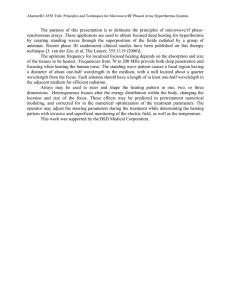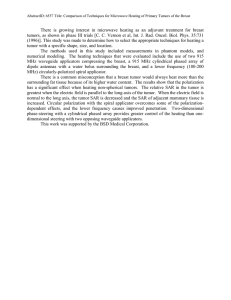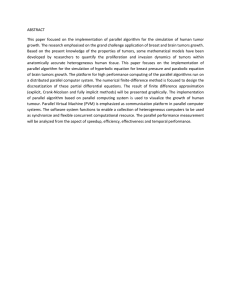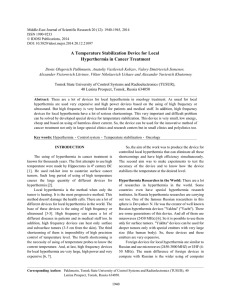Chapter 12 Therapeutic Heating Applications of Radio Frequency Energy C-K. Chou
advertisement
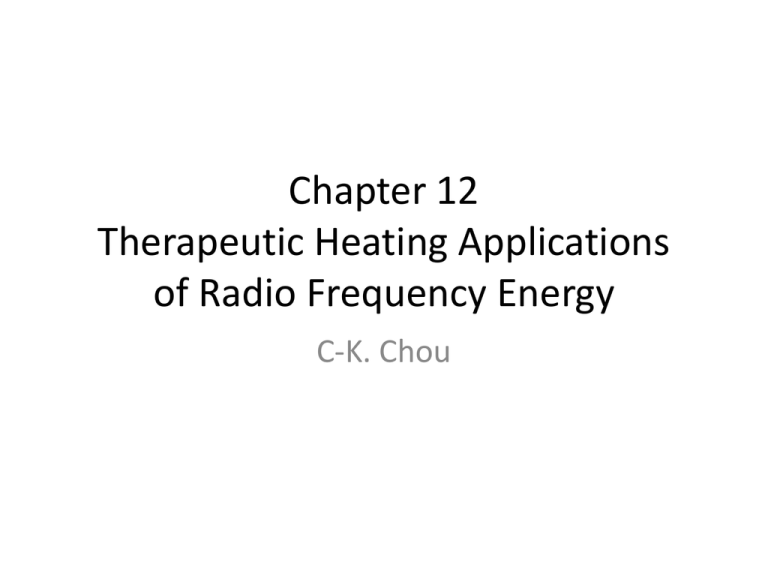
Chapter 12 Therapeutic Heating Applications of Radio Frequency Energy C-K. Chou Applications Heating Using RF • 1. Relieving pain from strains and sprains • 2. Increasing blood flow • 3. Combining hyperthermia (42-45o C) with radiation treatment of cancers. • 4. Radio Frequency Ablations of tumors. (50 to 100o C) Major Issues • 1. Measurement and control of the temperature distributions. • 2. RF is hard to localize to the desired region because of long wave length • 3. Differential heating of tissue types • fat , bone vs muscles, liver etc. • 4. Blood flow cooling is both a positive and negative. Mechanism of Heating • 1. Resistive heating σE2 • 2. Dielectric heating ε’’ or σ=ωεo ε” Typical Heating Pattern at 50W Limits • 1. Need to get to high enough temperature 42-44o C but not so high as to carbonize the tissue. • 2. Need to stay hot for long enough to effect the cancer but not so long as to raise the temperature of the normal tissue to damaging levels. (≈45o C) • 3. For ablation you want ΔT= 15 to 60o C for a short time < 6min Cancer Treatment • 1. Hyperthermia alone not very effective. • 2. Hyperthermia plus Radiation Treatment better. • 3. The synergism of RT and HT is the thermal killing of hypoxic and S phase DNA syntheses cell that are resistive to radiation alone. • 4. The heating can also increase the effectiveness of the chemotherapy drugs. Problems • 1. It is hard to get the heating just where you want it. • 2. It is hard to control the temperature to the very narrow range you need. • 3. The equipment is expensive. RF Hyperthermia Plus MRI Clinical Trials As of 2006 • 1. Some success – A breast cancer trial – HT + RT compared to RT alone 59% vs 41% – Head and Neck Cancer trail – HT +RT 58% vs 20% .2 Superficial Malignancies HT +RT 32% vs 30% 3. Malignant Melanoma RT followed by HT 46% vs 28% RF Ablation or RFA • 1. Use for correcting cardiac Arrhythmias • 2. Heat source for inducing coagulation necrosis in tumors. • 3, Heat to 50o C or more However less than 100o C. Higher temperatures lead to faster results • 4. You want to maintain this temperature over the entire target volume for 4 =6 minutes Exposures • 1. Typical 10 to 30min. • 2. For a single electrode coagulated volume less than 1.6cm diameter. • 3. Larger volumes with multiple electrodes Results • 1. On over 3000 RFA treated patients with small percutaneous (<3cm) liver tumors. • 2 Complete Local Response averaged 70-75% for 3-5 cm tumors but only 25% for larger tumors. • 3. 40-50% survival rates at 5 years. • 4. Other tumors similar results.
